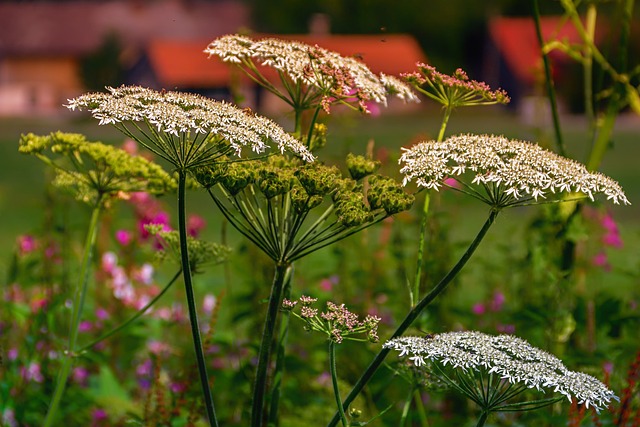Achillea aka Yarrow is NOT OK for Pets: It is Poisonous to Dogs & Cats
I have noticed that it is often included in wildflower mixes so if you see it pop up, yank it like a weed because it is NOT pet safe. Catchfly is pet safe and looks a lot like Achillea or its common name, Yarrow, so that is another option if you like the tall plant with clustered flowers.
So you know, we check the flowers we feature on our site with the ASPCA and do extensive internet research for both the common and scientific name just to be super pet safe. If we cannot find direct reference, we check up to genus and so on until we can confirm whether a plant is toxic or non toxic to both cats and dogs. If we are not sure, or get contradictory information, we do not include it. Many of the plants featured we have grown successfully in our own pet safe garden in Northern California. You can see many of garden stars in photos from Lovie’s Pet Safe Garden.

Physical Attributes
Yarrow (Achillea millefolium) is an herbaceous perennial with finely divided, feathery green or grayish-green foliage. It produces flat-topped clusters of small white, yellow, pink or red flowers at the tops of upright stems. The flower heads are comprised of 20-25 ray florets surrounding dense centers of tiny disc florets. Plants typically grow 1-3 feet tall.[1][2][3]
General Care Tips
- Plant yarrow in full sun to partial shade locations with well-draining soil.[1][2]
- Water regularly until established, then allow soil to dry slightly between waterings as yarrow is drought tolerant.[1][2]
- Divide clumps every 2-3 years in early spring to rejuvenate.[1]
- Deadhead spent blooms to encourage continued flowering.[1][2]
- Yarrow readily self-sows if allowed to go to seed.[2]
- Apply a balanced fertilizer in early spring if desired.[1]
Fun Facts
- The name “yarrow” is derived from the Greek word “achiro” meaning to stop bleeding, referring to its historical use as a wound herb.[3]
- Yarrow has been used medicinally for centuries to treat fevers, rashes, and stomach disorders.[2]
- The foliage has a pleasant, slightly pungent aroma when crushed.[2]
- Yarrow attracts many beneficial insects like bees, butterflies, and ladybugs to the garden.[1][2]
- It is considered one of the most drought-tolerant perennials.[1]
- Yarrow makes an excellent, long-lasting cut or dried flower.[2]
Citations:
[1] https://www.picturethisai.com/wiki/Achillea_millefolium.html
[2] https://www.wildflower.org/plants/result.php?id_plant=ACMI2
[3] https://assets.gov.ie/137085/f724fea1-b9b9-47bf-9a50-4e4e775b24fd.pdf
[4] https://www.monrovia.com/be-inspired/lavender-plant-care-guide.html
[5] https://lovflowers.co.uk/blogs/news/craspedia





